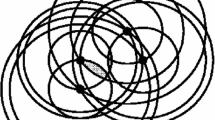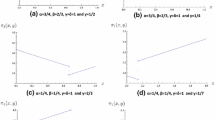Abstract
We demonstrate the important consequence of one particular type of voter behavior: the “differentiation” (“no-quibbling”) constraint that alternatives too similar to the alternative which they might replace will not be considered. We find that imposition of a sufficient differentiation norm leads to stable outcomes of decision making in a spatial context. We also briefly consider the potential effects of other possible constraints on feasible choices, especially as these might synergistically interact with choices based on “no-quibbling.”
Similar content being viewed by others
References
BanksJeffery. (1985). “Sophisticated Voting Outcomes and Agenda Control,”Social Choice and Welfare 1(4), 295–306.
DavisOtto, Morris H.DeGroot, and MelvinHinich. (1972). “Social Preference Orderings and Majority Rule,”Econometrica 40, 147–157.
DenzauArthur, WilliamRiker, and KennethShepsle. (1985). “Farquharson vs. Fenno: Sophisticated Voting and Home Style,”American Political Science Review 79: 1117–1134.
FarquharsonRobin. (1970).Theory of Voting, New Haven, CT: Yale University Press.
FeldScott. L., and BernardGrofman. (1991). “Incumbency Advantage, Voter Loyalty and Benefit of the Doubt,”Journal of Theoretical Politics 3(2), 115–137.
FeldScott L., BernardGrofman, CharlesHartley, MarkKilgour, and NicholasMiller. (1987). “The Uncovered Set in the Spatial Context,”Theory and Decision 23: 129–156.
FeldScott L., BernardGrofman, and NicholasMiller. (1988). “Centripetal Forces in Spatial Voting: On the Size of the Yolk,”Public Choice 59, 37–50.
FeldScott L., BernardGrofman, and NicholasMiller. (1989). “The Limits of Agenda Control in Spatial Voting Games,”Mathematical and Computer Modeling 12(4/5), 405–416. Reprinted in Paul E. Johnson (ed.),Mathematical Modeling in Political Science. Oxford: Pergamon Press (1989).
FerejohnJohn A., Richard D.McKelvey, and EdwardPackel. (1984). “Limiting Distributions for Continuous State Markov Models.”Social Choice and Welfare 1, 45–67.
HoffmanElizabeth, and EdwardPackel. (1982). “A Stochastic Model of Committee Voting with Exogenous Costs: Theory and Experiments,”Behavioral Science 27, 43–56.
Koehler, David H. (1990). “The Size of the Yolk: Computations for Odd and Even-numbered Committees,”Social Choice and Welfare (April), 231–245.
KrehbielKeith. (1986). “Sophisticated and Myopic Behavior in Legislative Committees: An Experimental Study,”American Journal of Political Science 30(3) (August), 542–561.
McKelveyRichard D. (1976). “Intransitivities in Multidimensional Voting Models and Some Implications for Agenda Control,”Journal of Economic Theory 12, 472–482.
McKelveyRichard D. (1979). “General Conditions for Global Intransitivities in Formal Voting Models,”Econometrica 47, 1085–1112.
McKelveyRichard D. (1986). “Covering, Dominance, and Institution Free Properties of Social Choice,”American Journal of Political Science, 30(2) (May), 283–315.
MillerNicholas. (1983). “The Covering Relation in Tournaments: Two Corrections,”American Journal of Political Science 27(2) (May), 328–385.
MillerNicholas, BernardGrofman, and Scott L.Feld. (1990). “Cycle Avoiding Trajectories and the Strategic Agendas, and the Duality of Memory and Foresight: An Informal Exposition,”Public Choice 64: 265–277.
MillerNicholas, BernardGrofman, and Scott L.Feld. (1989). “The Geometry of Majority Rule,”Journal of Theoretical Politics 1(4), 379–406.
PlottCharles. (1967). “A Notion of Equilibrium and Its Possibility under Majority Rule,”American Economic Review 57, 787–806.
RikerWilliam. (1982).Liberalism Against Populism: A Confrontation Between the Theory of Democracy and the Theory of Social Choice. San Francisco: W.H. Freeman.
SchofieldNorman. (1978). “Instability of Simple Dynamic Games,”Review of Economic Studies 45, 575–594.
SchofieldNorman. BernardGrofman, and Scott L.Feld. (1988). “The Core and the Stability of Group Choice in Spatial Voting Games,”American Political Science Review 82(1), 195–211.
Schofield, Norman J., and Craig A. Tovey. (1992). “Probability and Convergence for a Supra Majority Rule with Euclidean Preferences.” Political Economy Working Paper, School of Business and Center in Political Economy, Washington University at St. Louis (January).
ShepsleKenneth A. (1979a). “The Role of Institutional Structure in the Creation of Policy Equilibrium.” In Douglas W.Rae and Theodore J.Eismeir (eds.),Public Policy and Public Choice, Vol. 7, Beverly Hills: Sage, pp. 96–111.
ShepsleKenneth A. (1979b). “Institutional Arrangements and Equilibrium in Multidimensional Voting Models,”American Journal of Political Science 23, 27–60.
Tovey, Craig A. (1992). “The Almost Surely Shrinking Yolk.” Political Economy Working Paper. School of Business and Center in Political Economy, Washington University (January).
TullockGordon. (1967).Toward a Mathematics of Politics. Ann Arbor: University of Michigan.
WeingastBarry. (1979). A Rational Choice Perspective on Congressional Norms.American Journal of Political Science 23: 245–262.
WuffleA, BernardGrofman, Scott L.Feld, and GuillermoOwen. (1989). “Finagle's Law and the Finagle Point, A New Solution Concept for Two-Candidate Competition in Spatial Voting Games,”American Journal of Political Science 33(2), 348–375.
Author information
Authors and Affiliations
Rights and permissions
About this article
Cite this article
Feld, S.L., Grofman, B. Stability induced by “no-quibbling”. Group Decis Negot 5, 283–294 (1996). https://doi.org/10.1007/PL00020690
Issue Date:
DOI: https://doi.org/10.1007/PL00020690




